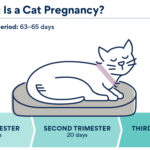What Does It Mean When A Cat Shakes His Tail? A cat’s tail movement is a key indicator of their mood, much like how dogs use their tails to express themselves. In this comprehensive guide created by solcat.net, we will dive into the various tail movements of cats, unraveling the hidden meanings behind each twitch, swish, and quiver. By understanding your cat’s tail language, you can foster a deeper connection and provide a more supportive environment for your feline friend, while accessing reliable cat care information and a vibrant community of cat lovers.
1. Decoding Cat Tail Language: An Introduction
Understanding what your cat is trying to tell you can significantly improve your bond. Cats use their tails, along with their eyes, ears, and overall body posture, as crucial communication tools. Being able to decode these signals helps you understand how your cat feels in different situations, whether they’re happy, fearful, or even in pain. This skill lets you create an environment where your cat feels safe, loved, and understood, which is essential for their well-being. By paying attention to these subtle cues, you can better cater to your cat’s needs and ensure they live a joyful and stress-free life.
2. The Upright Tail: Confidence and Sociability
2.1. What does it mean when a cat holds his tail straight up?
When a cat holds their tail straight up, it’s a sign of confidence, happiness, and a friendly approach. According to research from the University of Southampton in 1997, cats are more likely to approach a cat-shaped figure with a raised tail, highlighting this gesture as a positive social signal. This posture often indicates a friendly greeting, similar to how kittens greet their mothers. If your cat approaches you with their tail held high, it’s an invitation for interaction, making it a great time to offer pets or engage in play.
 Illustration of a happy cat holding their tail straight up
Illustration of a happy cat holding their tail straight up
2.2. How to respond to a cat with an upright tail?
When your cat greets you with an upright tail, they are seeking attention and affection. Approach them gently, speak in a soft tone, and offer a gentle petting session. Focus on areas they enjoy being touched, such as their head, cheeks, or under their chin. Engaging in play is also a great option. Use a favorite toy to stimulate their hunting instincts and provide physical activity. Responding positively to this signal reinforces your bond with your cat and encourages further social interactions.
3. The Question Mark Tail: An Invitation
3.1. What does it mean when a cat’s tail looks like a question mark?
A tail that resembles a question mark—upright with a curl at the end—signals that your cat is happy and approachable, extending an invitation to interact. While you might be tempted to pet the curled tip of the tail, cats often prefer being petted around their facial glands, such as their cheeks, under their chin, and near their ears. This position is a clear sign that your cat is in a playful and affectionate mood.
 Illustration of a cat with a tail that looks like a question mark
Illustration of a cat with a tail that looks like a question mark
3.2. The best way to interact with a cat showing a question mark tail?
When your cat’s tail forms a question mark, they’re inviting you to engage. Instead of focusing on the tail, gently stroke their face around the cheeks, under the chin, and near the ears, as this stimulates their scent glands and makes them feel secure and loved. Play sessions are also a fantastic way to connect. Use toys that mimic prey to spark their hunting instincts and provide a fun, engaging experience.
4. The Low Tail: Fear or Anxiety
4.1. What does it mean when a cat holds his tail low to the ground?
A cat holding their tail low, below the level of their back, indicates they are feeling frightened or anxious. If the tail is tucked between their legs, it signifies a higher level of fear or possible pain. This posture is a clear sign that your cat is experiencing discomfort and needs a safe and calm environment. Recognizing this signal is crucial for providing the necessary support and comfort to alleviate their distress.
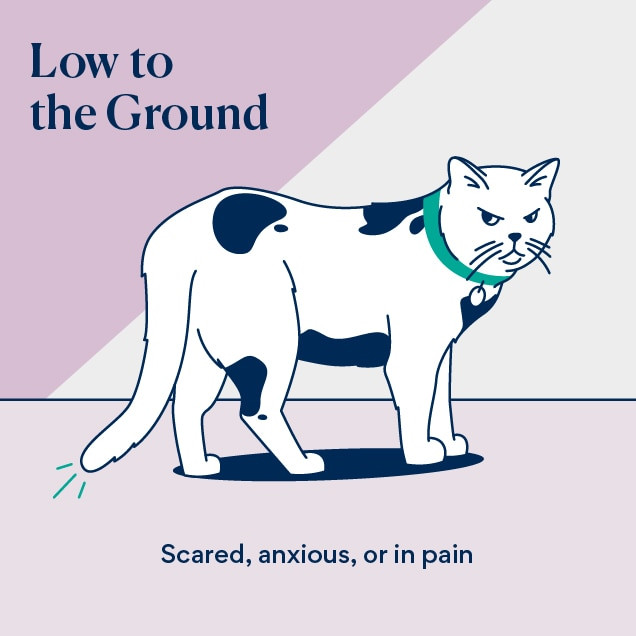 Illustration of cat tail language of a tail held low to the ground
Illustration of cat tail language of a tail held low to the ground
4.2. How to comfort a cat with a low tail?
If your cat is holding their tail low, it’s important to create a calm and secure environment. Remove any potential stressors, such as loud noises or unfamiliar people. Offer them a quiet space where they can retreat and feel safe, like a comfortable bed or a secluded corner. Speak in a soothing voice and avoid sudden movements. If the behavior persists, consult with a veterinarian to rule out any underlying medical issues or to discuss strategies for managing anxiety.
5. The Puffed-Up Tail: Fear and Defense
5.1. What does it mean when a cat’s tail is puffed up?
A puffed-up tail, accompanied by an arched back, is a classic Halloween-cat posture indicating that your cat is startled or frightened by a significant threat. The hair stands on end, a reaction known as piloerection, making them appear larger as a defensive mechanism. This is a clear signal that your cat feels threatened and wants to be left alone. Approaching them in this state can be perceived as further aggression, potentially leading to a defensive reaction.
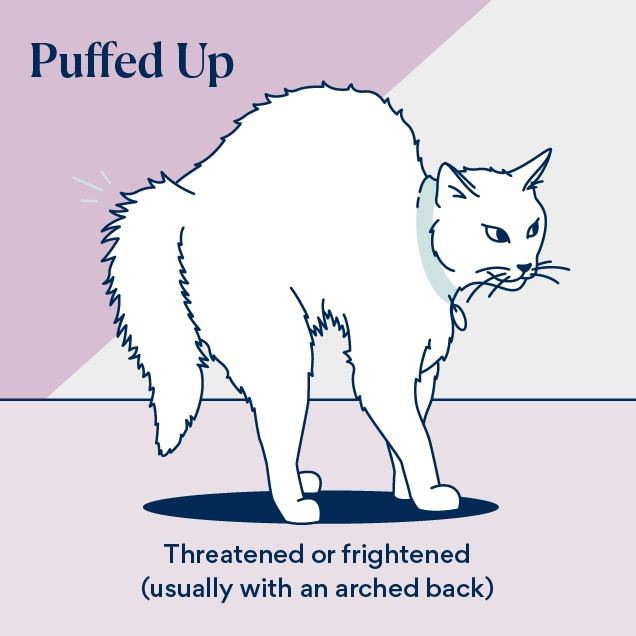 Illustration of a cat with a puffed-up tail
Illustration of a cat with a puffed-up tail
5.2. What steps to take when a cat has a puffed-up tail?
When your cat’s tail is puffed up, it’s crucial to minimize their stress by identifying and removing the source of their fear. This could be other animals, loud noises, or unfamiliar visitors. Allow your cat to retreat to a safe space where they feel secure. Avoid direct interaction, as this could escalate their fear and lead to aggression. Once the environment is calm, your cat will gradually relax and return to their normal state.
6. The Wrapped Tail: Fear, Pain, or Illness
6.1. What does it mean when a cat wraps his tail around his body?
If your cat is sitting or lying down with their tail wrapped around their body, they may be frightened, defensive, in pain, or feeling unwell. This posture is a protective mechanism, indicating that they are trying to shield themselves from further harm or discomfort. It’s essential to recognize this sign and respond with care to ensure their well-being.
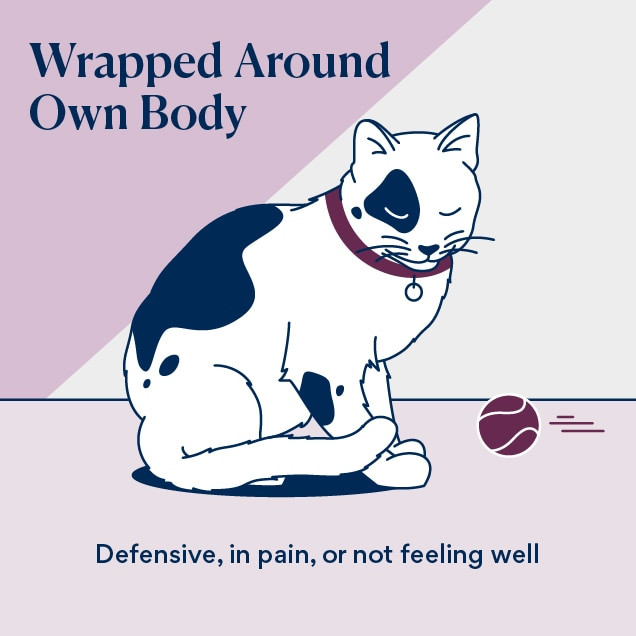 Illustration of cat tail language when a cat wraps their tail around their body
Illustration of cat tail language when a cat wraps their tail around their body
6.2. How to care for a cat wrapping his tail around his body?
When you notice your cat wrapping their tail around their body, it’s important to end any interaction and assess their environment for potential stressors. Ensure they have a quiet, comfortable space to retreat to. If the behavior persists for more than a few days, it’s crucial to consult with a veterinarian to rule out any underlying pain or illness. Early detection and treatment can significantly improve your cat’s quality of life.
7. The Thrashing Tail: Irritation or Anger
7.1. What does it mean when a cat thrashes his tail?
When a cat thrashes their tail or thumps it on the ground, they are expressing irritation, annoyance, or anger. This behavior indicates that something is bothering them and serves as a warning signal. It’s important to recognize this sign and adjust your behavior to avoid escalating the situation. Ignoring this warning can lead to hissing, growling, swatting, or even biting.
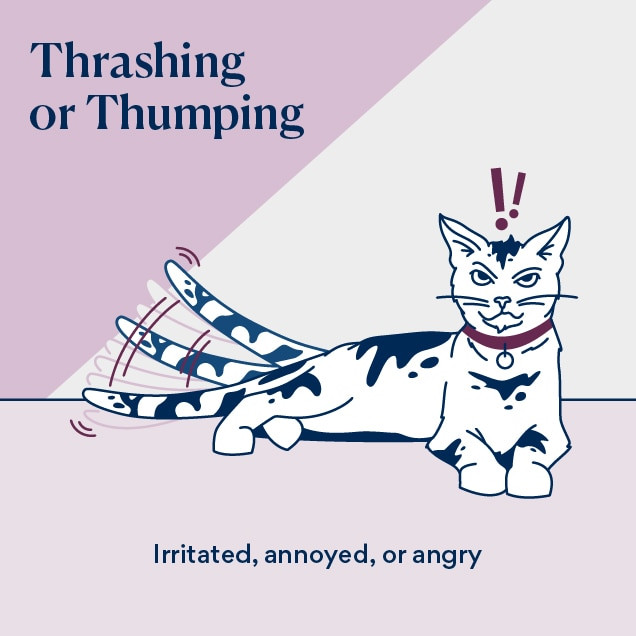 Illustration of a cat thrashing their tail
Illustration of a cat thrashing their tail
7.2. How should you react to a cat thrashing his tail?
If your cat starts thrashing their tail while you are petting them, it’s a clear signal to stop. Respect their boundaries and give them space. Avoid any further interaction until they have calmed down. Identifying the source of their irritation can help prevent future incidents. This could be anything from overstimulation to an uncomfortable touch.
8. The Twitching Tail: Mild Irritation or Hunting
8.1. What does it mean when a cat twitches the end of his tail?
Cats twitch the end of their tails when they are hunting and playing, or when they are mildly irritated or frustrated. The context is key. If they are focused on a toy or something else that interests them, it’s likely a sign of excitement. However, if they are not engaged in play or hunting, the twitching tail may indicate annoyance. Observing the surrounding environment and other body language cues can help you accurately interpret their mood.
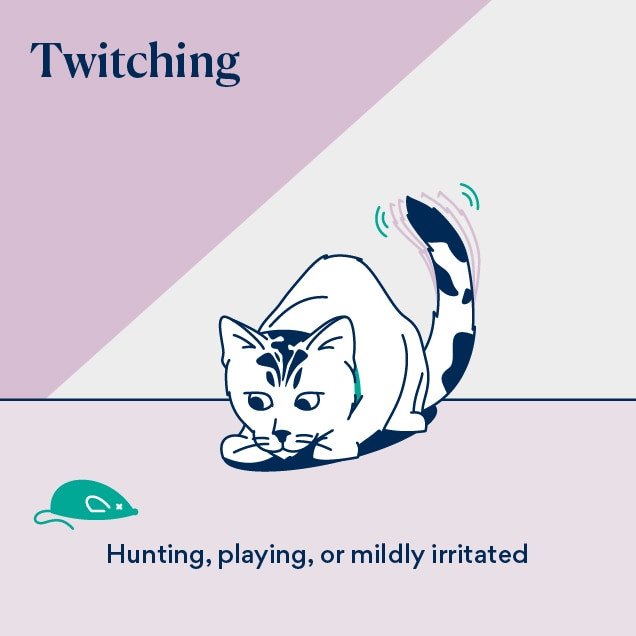 Illustration of cat tail language when a cat is twitching their tail
Illustration of cat tail language when a cat is twitching their tail
8.2. How to distinguish between playful excitement and irritation?
To distinguish between playful excitement and irritation, observe your cat’s overall body language and the situation. If they are focused on a toy, stalking, or pouncing, the twitching tail is likely a sign of excitement. If they are in a tense posture, ears back, or hissing, the twitching tail indicates annoyance. Adjust your interaction accordingly to ensure your cat remains comfortable and happy.
9. The Swishing Tail: Focus and Predatory Behavior
9.1. What does it mean when a cat swishes his tail from side to side?
When your cat slowly swishes their tail from side to side, they are likely intently focused on something, such as a toy, another animal, or something outside. This behavior often precedes a pounce, indicating they are engaging in predatory behavior. Allowing them to engage in these activities provides important enrichment and mental stimulation.
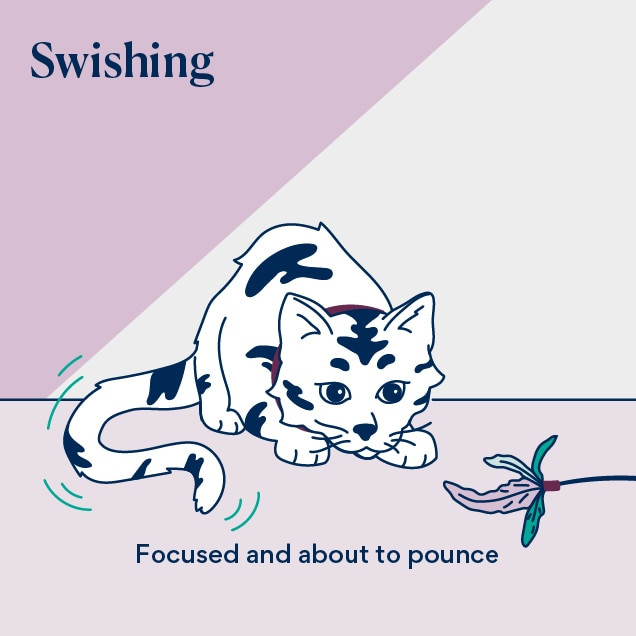 Cat tail language illustration of a cat swishing their tail
Cat tail language illustration of a cat swishing their tail
9.2. How to encourage healthy predatory behavior in cats?
Encourage healthy predatory behavior by providing toys that mimic prey, such as feather wands or laser pointers. Create opportunities for them to stalk, chase, and pounce. Rotate toys regularly to keep them engaged and prevent boredom. These activities not only provide physical exercise but also satisfy their natural instincts, contributing to their overall well-being.
10. The Quivering Tail: Excitement or Marking
10.1. What does it mean when a cat quivers his tail?
Your cat may quiver their tail when they are especially excited to see you or another cat. However, sometimes, a quivering tail held straight up while backing up against a vertical surface may indicate urine marking. Understanding the context is crucial for interpreting this behavior accurately.
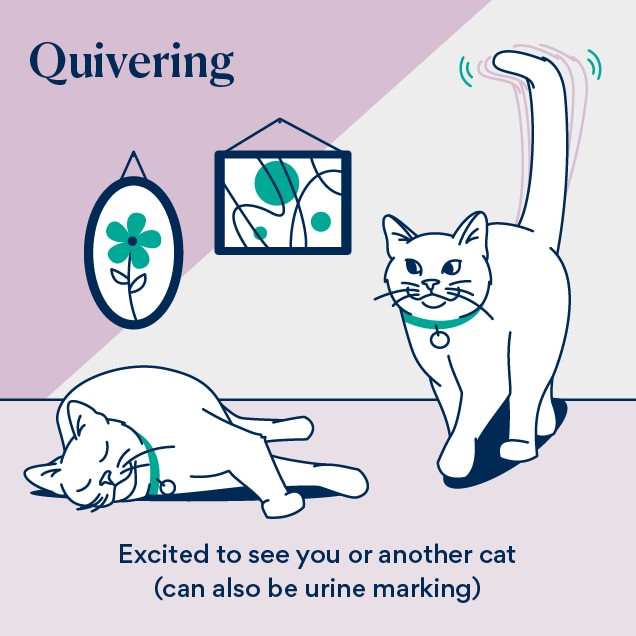 Illustration of a cat tail illustrating a quivering tail
Illustration of a cat tail illustrating a quivering tail
10.2. How to manage tail quivering behavior?
If your cat quivers their tail when greeting you, it’s a sign of excitement and happiness. Respond with affection and positive reinforcement. If the quivering tail is accompanied by backing up against a vertical surface, it may be urine marking. In this case, consult with a veterinarian to rule out any medical issues and discuss strategies for managing this behavior, such as providing more vertical territory or using pheromone sprays.
11. Tail Wrapping Around You: Affection and Bonding
11.1. What does it mean when a cat wraps his tail around you?
Cats may wrap their tails around people or intertwine their tails with other cats as a greeting, similar to handshakes or hugs. This tail-wrapping behavior demonstrates a willingness to interact and signifies affection and bonding. It’s a positive sign of a strong and trusting relationship.
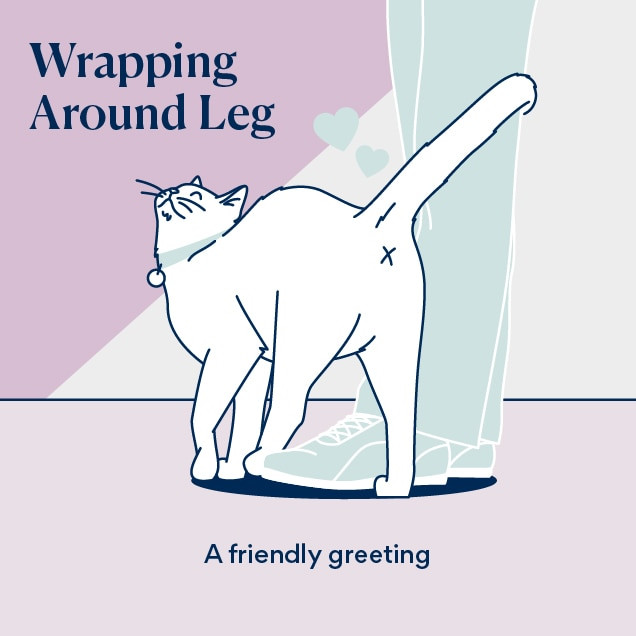 Illustration of cat tail language when a cat wraps their tail around human legs
Illustration of cat tail language when a cat wraps their tail around human legs
11.2. How to strengthen the bond with your cat through tail wrapping?
When your cat wraps their tail around you, respond with gentle affection, such as soft petting or a comforting word. This reinforces the positive association and strengthens your bond. Create regular opportunities for interaction and play to further enhance your relationship. A strong bond contributes to your cat’s overall happiness and well-being.
12. Additional Factors Influencing Cat Tail Language
12.1. Environmental factors affecting cat tail language
Environmental factors can significantly influence a cat’s tail language. Loud noises, unfamiliar people, or changes in the home can cause stress and anxiety, leading to defensive tail postures like a low or puffed-up tail. Creating a stable, predictable environment can help reduce stress and promote positive tail signals.
12.2. Health conditions influencing cat tail language
Underlying health conditions can also affect a cat’s tail language. Pain or illness can cause a cat to adopt a protective posture, such as wrapping their tail around their body. If you notice any persistent changes in your cat’s tail behavior, it’s essential to consult with a veterinarian to rule out any medical issues.
12.3. Breed-specific differences in cat tail language
While general tail signals apply to most cats, there can be some breed-specific differences. For example, some breeds may be more vocal or expressive with their tails than others. Understanding these nuances can help you better interpret your cat’s communication.
13. Seeking Professional Advice
13.1. When to consult a veterinarian about cat tail language?
If you notice any sudden or persistent changes in your cat’s tail language, it’s essential to consult with a veterinarian. This is especially important if the changes are accompanied by other signs of illness, such as loss of appetite, lethargy, or changes in litter box habits. A veterinarian can help rule out any underlying medical issues and provide appropriate treatment.
13.2. When to consult a cat behaviorist about cat tail language?
If you’re struggling to understand your cat’s tail language or are dealing with behavioral issues, consulting a cat behaviorist can be beneficial. A behaviorist can provide personalized guidance and strategies for improving communication and addressing any underlying behavioral problems.
14. Case Studies on Understanding Cat Tail Language
14.1. Case study 1: Identifying stress through tail language
A cat named Whiskers suddenly started holding his tail low and hiding under the bed. His owner noticed the change in tail language and realized Whiskers was stressed due to construction noise outside. By providing a quiet, safe space and using calming pheromone sprays, the owner helped Whiskers feel secure, and his tail posture returned to normal.
14.2. Case study 2: Enhancing bond through responding to tail language
A cat named Oliver often greeted his owner with an upright, quivering tail. The owner responded with gentle petting and play, reinforcing the positive interaction. Over time, Oliver became even more affectionate and trusting, demonstrating the power of understanding and responding to cat tail language.
15. Resources for Further Learning
15.1. Recommended books on cat behavior and communication
- “The Cat Whisperer” by Mieshelle Nagelschneider
- “Think Like a Cat” by Pam Johnson-Bennett
- “Decoding Your Cat” by American College of Veterinary Behaviorists
15.2. Online resources and websites
- Cornell Feline Health Center: Provides comprehensive information on cat health and behavior.
- American Animal Hospital Association (AAHA): Offers resources for pet owners, including articles on cat behavior.
- solcat.net: Delivers updated information on cat care, behavior, and health.
16. Understanding Tail Language: A Summary Table
| Tail Position | Meaning | How to Respond |
|---|---|---|
| Straight Up | Confidence, Happiness, Friendly Greeting | Offer pets, engage in play |
| Question Mark | Happy, Approachable, Invitation to Interact | Pet face, engage in play |
| Low to the Ground | Frightened, Anxious | Provide calm space, remove stressors |
| Puffed Up | Startled, Frightened, Defensive | Remove triggers, allow retreat to safe space |
| Wrapped Around Body | Frightened, Defensive, Pain, Feeling Unwell | End interaction, ensure stress-free environment, consult vet if persistent |
| Thrashing/Thumping | Irritated, Annoyed, Angry | Stop petting, give space |
| Twitching End of Tail | Hunting, Playing, Mildly Irritated, Frustrated | Observe context, adjust interaction accordingly |
| Swishing Side to Side | Focused, Predatory Behavior | Provide enrichment, allow stalking and pouncing |
| Quivering | Excited, Happy, Urine Marking | Respond with affection, consult vet if urine marking |
| Wrapped Around You (Human/Cat) | Affection, Bonding | Respond with gentle affection, create opportunities for interaction |
17. FAQ: Decoding Cat Tail Language
17.1. Why does my cat’s tail twitch when I pet him?
Your cat’s tail twitching while you pet them can indicate mild irritation or overstimulation. Pay attention to other body language cues, such as flattened ears or a tense posture, and adjust your petting accordingly.
17.2. Is it normal for my cat to puff up his tail when he sees another cat?
Yes, it’s normal for a cat to puff up their tail when they see another cat, especially if they feel threatened. This is a defensive mechanism to appear larger and more intimidating.
17.3. What does it mean when my cat holds his tail straight up and vibrates?
When your cat holds their tail straight up and vibrates, it usually means they are very excited to see you or another cat. It’s a sign of happiness and anticipation.
17.4. Why does my cat wrap his tail around my legs?
Your cat wrapping their tail around your legs is a sign of affection and bonding. It’s their way of greeting you and showing that they feel comfortable and secure in your presence.
17.5. How can I tell if my cat is in pain based on his tail position?
If your cat is in pain, they may hold their tail low or wrapped around their body. They may also exhibit other signs of discomfort, such as hiding, decreased appetite, or changes in grooming habits.
17.6. What does it mean if my cat’s tail is twitching while he’s sleeping?
A twitching tail while your cat is sleeping is often a sign that they are dreaming. It’s usually nothing to worry about unless accompanied by other concerning symptoms.
17.7. Can a cat’s tail language change with age?
Yes, a cat’s tail language can change with age. Older cats may be less expressive or have decreased mobility, affecting their tail movements.
17.8. How do I introduce my cat to a new pet to avoid negative tail language?
When introducing your cat to a new pet, do it gradually and in a controlled environment. Monitor their tail language for signs of stress or aggression, and provide plenty of space and resources for both animals.
17.9. Should I be concerned if my cat never moves his tail?
If your cat rarely moves their tail, it could indicate a medical issue, such as nerve damage or arthritis. Consult with a veterinarian to rule out any underlying health problems.
17.10. Can I train my cat to communicate with his tail more clearly?
While you can’t directly train your cat to communicate with their tail more clearly, you can learn to recognize and respond to their subtle cues, reinforcing positive interactions and strengthening your bond.
18. Conclusion: Enhancing Your Bond Through Understanding
Understanding cat tail language is a powerful tool for building a stronger, more fulfilling relationship with your feline companion. By paying attention to the subtle movements and positions of your cat’s tail, you can gain valuable insights into their emotional state and respond in a way that fosters trust, security, and affection. Visit solcat.net for more information and resources on cat care, behavior, and health. Discover a wealth of articles, images, videos, and a vibrant community of cat lovers dedicated to providing the best possible lives for their feline friends. Explore solcat.net today and deepen your understanding and appreciation of the wonderful world of cats.
Address: 950 Alaskan Way, Seattle, WA 98104, United States
Phone: +1 (206) 386-4000
Website: solcat.net

